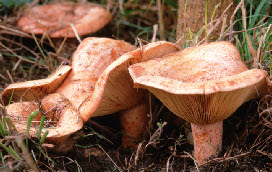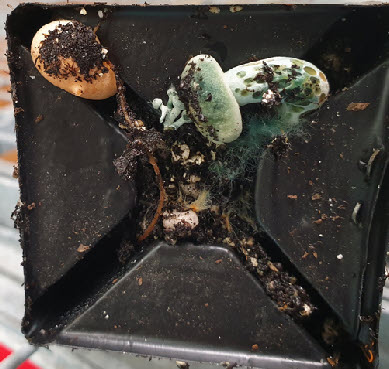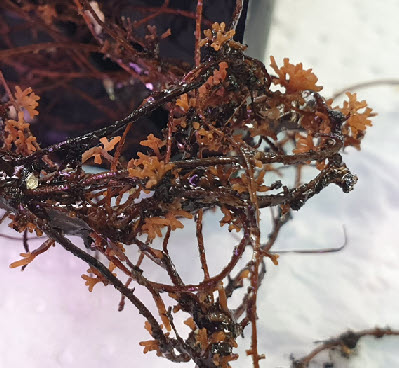
Truffles and mushrooms (Consulting) Limited
© Truffles and Mushrooms (Consulting) Ltd
Saffron milk cap cultivation

Saffron milk cap on radiata pine produced by Truffles and Mushrooms (Consulting) Limited 10 months after inoculation. The left photo shows two precocious saffron milk cap mushrooms fruiting though the drainage hole in a pot. The characteristic orange mycorrhizas are shown on the right.
The saffron milk cap is loved by chefs for the colour it brings to a meal, its firm texture, and fruity, faintly peppery flavour that has helped make it the number one mushroom in Spain and a favourite in continental Europe since Roman times. The saffron milk cap gets its common name from the bright orange milk that bleeds from the mushrooms when they are cut or damaged. This, the concentric rings of carrot-coloured blotches on the surface of the cap and stalk and its tendency to turn green with age or after rough handling, makes this mushroom easily recognisable.
The saffron milk cap grows on the roots of pines where it forms beneficial mycorrhizas. These are orange or orange-brown and are easily seen in the litter layer and soil under infected trees with the aid of a hand lens (see above). Known hosts include Pinus radiata (radiata pine), Pinus sylvestris (Scots pine) and pine nut (Pinus pinea). It is found throughout Continental Europe and Western Russia, and from the north of Sweden to the south of Spain. The saffron milk cap has also made the accidental journey to Australia, Chile and South Africa probably on the roots of imported trees. It is impossible to estimate total world production but the size of the market can be gauged from the limited literature available. For example, in the small village of Laspaúles, Huesca, Spain, it was reported that one tonne of saffron milk cap was traded each day during the season whilst in east Asia thousands of tonnes of the similar species hatsudake (Lactarius hatsudake) are consumed each year. In 1997 Dr Ian Hall imported the saffron milk cap into New Zealand. The first saffron milk cap mycorrhized trees were produced by Prof. Yun Wang and grown in small experimental plantations around New Zealand in spring 2000. The first fruiting bodies were found by Yun Wang in coastal North Otago in 2003. The potential for producing these mushrooms in the Southern Hemisphere for off-season Northern Hemisphere markets is considerable and double cropping in New Zealand's exotic pine forests was considered. However, times have changed and having mushroom pickers wandering around forests does not marry well with the dangers of modern plantation forestry. So, in the future we suspect that the saffron milk cap is more likely to be grown as a dedicated crop like truffles. The saffron milk cap should be grown in a soil that suits the cultivation of the host pine as well as the fungus - a relatively low pH and low phosphorus are key soil requirements so soil testing during the planning stages is recommended particularly for large plantings.
Truffles & Mushrooms (Consulting) Limited produces saffron milk cap mycorrhized plants
(photograph above) and can assist in the appraisal of potential sites.
For prices or for a draft booklet please click email or telephone +64-3-454 3574 .
The saffron milk cap is loved by chefs for the colour it brings to a meal, its firm texture, and fruity, faintly peppery flavour that has helped make it the number one mushroom in Spain and a favourite in continental Europe since Roman times. The saffron milk cap gets its common name from the bright orange milk that bleeds from the mushrooms when they are cut or damaged. This, the concentric rings of carrot-
The saffron milk cap grows on the roots of pines where it forms beneficial mycorrhizas. These are orange or orange-
Truffles & Mushrooms (Consulting) Limited produces saffron milk cap mycorrhized plants
(photograph above) and can assist in the appraisal of potential sites.
For prices or for a draft booklet please click email or telephone +64-
If you need help planting a saffron milk cap grove please contact Bart Acres, telephone

